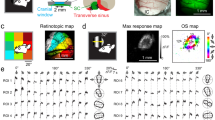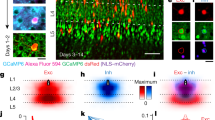Abstract
Neurons in the visual cortex are selectively responsive to light or dark bars presented at particular orientations1. On the basis of physiological data, this orientation selectivity is hypothesized as being due at least partially to intracortical inhibitory mechanisms2–6. But this hypothesis has been challenged by intracellular recordings indicating that excitatory inputs themselves are orientation-selective, so inhibition may not contribute to the observed selectivity7. Also, there is controversy about the presence of intracortical horizontal connections mediating inhibition for selectivity8–11 and about the theoretical validity of such inhibitory connections12–14. Using cross-correlation analysis of the activities of two neurons recorded simultaneously, we find that inhibitory interactions exist between cells with somewhat different, but not orthogonal, orientation preferences. This suggests that intracortical horizontal inhibition operates between 'orientation columns' to sharpen the orientation tuning of cortical neurons.
This is a preview of subscription content, access via your institution
Access options
Subscribe to this journal
Receive 51 print issues and online access
$199.00 per year
only $3.90 per issue
Buy this article
- Purchase on Springer Link
- Instant access to full article PDF
Prices may be subject to local taxes which are calculated during checkout
Similar content being viewed by others
References
Hubel, D. H. & Wiesel, T. N. J. Physiol., Lond. 160, 106–154 (1962).
Bishop, P. O., Coombs, J. S. & Henry, G. H. J. Physiol., Lond. 219, 659–687 (1971).
Blakemore, C. & Tobin, E. A. Expl Brain Res. 15, 439–440 (1972).
Benevento, L. A., Creutzfeldt, O. D. & Kuhnt, V. Nature 238, 124–126 (1972).
Sillito, A. M. J. Physiol., Lond. 250, 305–329 (1975).
Tsumoto, T., Eckart, W. & Creutzfeldt, O. D. Expl Brain Res. 34, 351–363 (1979).
Ferster, D. J. Neurosci. 6, 1284–1301 (1986).
Matsubara, J., Cynader, M., Swindale, N. V. & Stryker, M. P. Proc. natn. Acad. Sci. U.S.A. 82, 935–939 (1985).
Ts'o, D. Y., Gilbert, C. D. & Wiesel, T. N. J. Neurosci. 6, 1160–1170 (1986).
Kisvarday, Z. F. et al. Expl Brain Res. 64, 541–552 (1986).
LeVay, S. J. comp. Neurol 269, 265–274 (1988).
Rose, D. Vision Res. 19, 533–544 (1979).
Koch, C. & Poggio, T. in Models of the Visual Cortex (eds Rose, D. & Dobson, V. G.) 408–419 (Wiley, New York, 1985).
Koch, C. Soc. Neurosci. Abstr. 13, 1451 (1987).
Tsumoto, T., Masui, H. & Sato, H. J. Neurophysiol. 55, 469–483 (1986).
Hubel, D. H. & Wiesel, T. N. J. comp. Neurol. 158, 267–294 (1974).
Albus, K. Expl Brain Res. 24, 181–202 (1975).
Schoppmann, A. & Stryker, M. P. Nature 293, 574–576 (1981).
Moore, G. P., Segundo, J. P., Perkel, D. H. & Levitan, H. Biophys. J. 10, 876–900 (1970).
Bryant Jr, H. L., Marcos, A. R. & Segundo, J. P. J. Neurophysiol. 36, 205–225 (1973).
Toyama, K., Kimura, M. & Tanaka, K. J. Neurophysiol. 46, 202–214 (1981).
Michalski, A., Gerstein, G. L., Czarkowska, J. & Tarnecki, R. Expl Brain Res. 51, 97–107 (1983).
Aertsen, A. H. J. & Gerstein, G. L. J. Brain Res. 340, 341–354 (1985).
Matsubara, J. A., Cynader, M. S. & Swindale, N. V. J. Neurosci. 7, 1428–1446 (1987).
Somogyi, P., Kisvarday, Z. F., Martin, K. A. C. & Whitteridge, D. Neuroscience 10, 261–294 (1983).
Kisvarday, Z. F., Martin, K. A. C., Whitteridge, D. & Somogyi, P. J. comp. Neurol. 241, 111–137 (1985).
Blakemore, C., Carpenter, R. H. S. & Georgeson, M. A. Nature 228, 37–39 (1970).
Morrone, M. C., Burr, D. C. & Maffei, L. Proc. R. Soc. B216, 335–354 (1982).
Ramoa, A. S., Shadlen, M., Skottun, B. C. & Freeman, R. D. Nature 321, 237–239 (1986).
Douglas, R. J., Martin, K. A. C. & Whitteridge, D. Nature 332, 642–644 (1988).
Author information
Authors and Affiliations
Rights and permissions
About this article
Cite this article
Hata, Y., Tsumoto, T., Sato, H. et al. Inhibition contributes to orientation selectivity in visual cortex of cat. Nature 335, 815–817 (1988). https://doi.org/10.1038/335815a0
Received:
Accepted:
Issue Date:
DOI: https://doi.org/10.1038/335815a0
This article is cited by
-
The role of feedback projections in feature tuning and neuronal excitability in the early primate visual system
Brain Structure and Function (2021)
-
Altered modulation of gamma oscillation frequency by speed of visual motion in children with autism spectrum disorders
Journal of Neurodevelopmental Disorders (2015)
-
The Wagon Wheel Illusions and models of orientation selection
Journal of Computational Neuroscience (2011)
-
A morphological basis for orientation tuning in primary visual cortex
Nature Neuroscience (2004)
-
Dynamics of the orientation-tuned membrane potential response in cat primary visual cortex
Nature Neuroscience (2001)
Comments
By submitting a comment you agree to abide by our Terms and Community Guidelines. If you find something abusive or that does not comply with our terms or guidelines please flag it as inappropriate.



